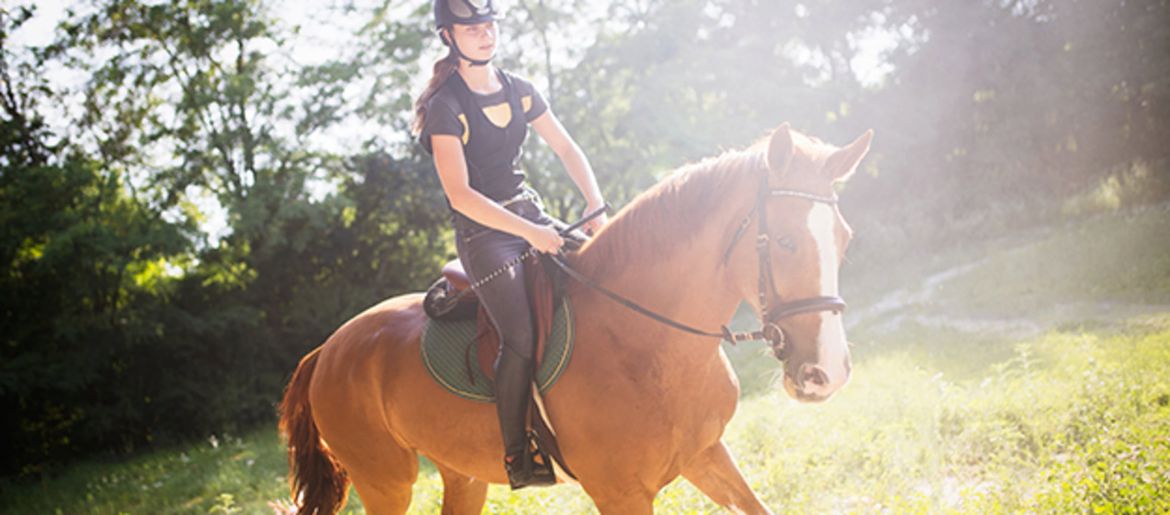Spring: Build the Strength and Endurance of Your Horses
There are many reasons why your horse might take a break from exercising. Injuries, weather and health can all influence your horse's training routine. After a break, it is important to slowly build up your horse's strength before riding the way you used to. Keep in mind that it can be very difficult for a horse that has not trained for a while to carry a rider - even if it is only for short distances.
Horses need to train the same way we humans do. We all know that if you haven't exercised for months, it's not a good idea to try to run a marathon. Even if you do finish, the consequences won't be worth it and your risk of injury increases dramatically. This logic also applies to horses. It is therefore important to slowly build up your horse's strength after a break in training. It is best to do this under the professional supervision of a trainer. We strongly recommend using a trainer as it ensure the safest conditions for your horse.
Here are some factors that can influence training:
| Positive influences | Negative influences |
| Short breaks | Long breaks |
| Good basic condition | Poor basic condition |
| Young horses | Older horses |
| Freestall barn | Closed stall in a stable |
| Strong horses | Horses prone to injury |
| Healthy before the break | Injured before the break |
| Taking plenty of time for your horse | Taking little time for your horse |
Here are a few tips for starting training again:
Take it slow
Depending on how fit your horse is after winter, it may be sufficient to only do muscle building training every other day. Start with less strenuous workouts and then slowly increase the duration and intensity of the workout. Also, make sure your horse takes plenty of breaks while working out.
Additionally, be really careful not to overdo it. If you notice that your horse is moving clumsily you need to stop. Other signs of exhaustion or discomfort may be gnashing teeth, a shaking head, timing errors or loss of motivation. Do not plan strenuous workouts back to back as they can be damaging to your horse.
For horses in poor condition, it can take up to three months to develop good basic muscle strength. This requires plenty of patience on your part.
Create a training plan
A training plan is always good because it gives you an overview and prevents making unnecessary mistakes. Base your plan on the goals you want to achieve.
This said, it is always important to remain flexible. If you have a strenuous workout planned but your horse is having a bad day, adjust the plan accordingly, skip that day or do something else instead.
Variety is the key
Varied workouts are more exciting for both the horse and the trainer. Varying the types of training stimuli you use also leads to much better strength and muscle building long term. Pole training, lunging or floor exercises are good for building muscle. Just be careful to start slowly.
Don't overdo it
Flexibility is very important. If you notice that your horse is already exhausted after a third of the training, you should take a break or stop for the day. When your horse trains too hard, it won't have enough time to recover between workouts. This increases the chance of injury.
Measuring your horse's heart-rate is a good way to track its fitness. This is especially helpful during breaks. Make sure your horse's heart rate has slowed to 100 beats per minute before you start working out again.
Walk your horse
Regularly walk your horse uphill as this trains the abdominal muscles, hindquarters and back muscles. A walk through a forest where there are obstacles is also good for muscle building.
Start riding slowly
When your horse has built up its muscles, you can slowly start riding again. First of all, you should always check whether its saddle still fits. If this is the case, a 15-minute ride is sufficient to start. From there you can slowly start building things up again.
Latest reviews
-
 5.0 (3)
5.0 (3)VEREDUS Super Sheen, 1 l
-20%- Knot-free for 2 weeks
- Shortens the cleaning time
- Does not stick or grease
£19.66 £24.58 (£19.66 / l)Delivery by December 24
-
 5.0 (3)
5.0 (3)Bense & Eicke TIGER Leather Black, 500 ml
-10%- Ideal for restoring colour
- For repair of cut edges
- Intensifies black leather
£17.69 £19.65 (£35.38 / l)Delivery by December 24
-
 5.0 (2)
5.0 (2)NATUSAT Linseed Oil Premium, 2.500 ml
- Particularly easy to digest
- With omega-3 fatty acids
- Promotes shine in fur and hair
£27.00 (£10.80 / l)Delivery by December 24
-
 5.0 (1)
5.0 (1)Cat's Love Advent Calendar, 48 g
-50%- Multiple treats per window
- Available while stocks last
- Grain-free, no added sugar
£10.57 £21.00 (£220.21 / kg)Delivery by December 24
Magazine Articles:
-
Great Britain: Free standard delivery from £79.90
-
Free
returns -
We operate in a
climate-conscious manner. More than 10.200 products
